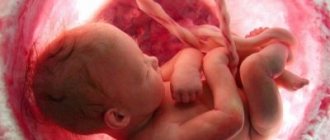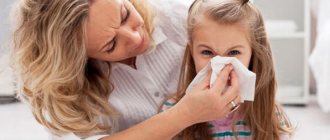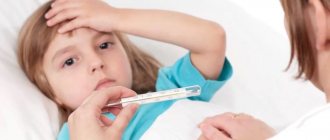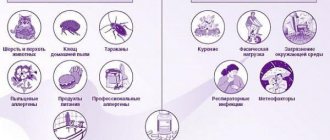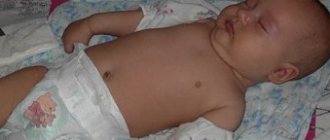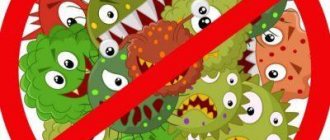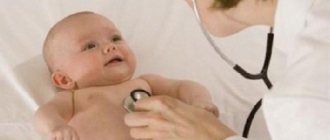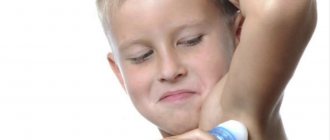Cough in infants
Infants are the most difficult to treat.
A baby has very narrow respiratory channels, which is why sputum accumulates faster, but leaves very slowly. What to do if a child cannot clear his throat? Only a doctor can prescribe the correct treatment. The doctor should listen to the child’s breathing and examine the oral cavity, assess the general condition of the baby. Sometimes mucus occurs because the baby is teething.
Unfortunately, a blocked airway can lead to suffocation. What to do in such a situation? First of all, be sure to call an ambulance. Keep the child upright and provide access to fresh air. You can notice the state of suffocation in time by the blueness of the nasolabial triangle and rapid breathing.
Benefits of coughing
When an inflammatory process occurs due to a viral or bacterial infection, the volume of sputum secreted by the bronchi increases significantly. If a child does not cough, sputum accumulates in the bronchi and lungs, becoming a favorable environment for the growth of bacteria. It is the accumulation of mucus in the lungs that causes pneumonia. For any respiratory disease, the child should be able to cough.
Popular pediatrician Evgeny Komarovsky is sure that if a one-year-old child with an unimpaired general condition coughs from time to time, the problem is not in the baby’s health, but in the quality of the air he breathes.
Therapeutic massage, how to do it correctly?
It is not easy to completely remove sputum from a baby. One of the most effective ways to do this is massage. The technique of performing such a massage is not very complicated; every mother can master it.
To begin with, the baby must be placed on his tummy, with gentle pressure, stroke the back in the “bottom-up” direction, but under no circumstances should you touch the spine. Move from top to bottom with gentle pinching. Turn the child onto his side and rub his side from bottom to top, repeat in the same way on the other side. Don't forget to hold the baby. With the baby lying on his back, massage the lung area (lightly stroke).
Turn him over onto his stomach again and do a massage like a “rail-sleeper”, with the edge of your palm lightly (very lightly!) tap on the back so that the baby barely feels it. The goal is to receive vibration, not “get through.”
You can strengthen the massage for your baby using natural oils - juniper, corn, peach, olive, wheat germ, which will help the child breathe and cough easier.
The massage technique is approximately the same for all children; only the pressure and the nature of the movements are adjusted. In young children, massage is carried out with stroking movements, and for tapping, not the whole palm is used, but several fingers.
An example of a massage that will help remove phlegm from a newborn: parents rub the baby’s back with stroking movements until slight redness appears. In this case, you need to touch the area where the bronchi are located, avoiding the spine and kidneys. It is recommended to warm up your back from the bottom up. In addition to stroking, you can use light pinching and pressing.
After the area has warmed up, the parents very lightly tap the back with their fingertips so that the mucus is separated from the walls of the bronchi and comes out with a cough. Komarovsky speaks very positively about such procedures, even in infancy, provided that parents perform the exercises correctly.
Another way when the child does not clear his throat. How to treat? Massage, but only in case of wet cough. It is useful because it stimulates blood flow, strengthens muscle fibers, and also increases the mobility of the ribs and stabilizes breathing.
There are also contraindications: fever, the child has recently eaten, a disease with complications, the baby has skin diseases or the child’s weight is below normal. It is better, of course, if it is done by a doctor. But parents themselves will be able to, most importantly, know how:
- It is necessary to turn the child onto his back.
- Use stroking movements to move your palms from bottom to top.
- Turn the child over onto his stomach, stroke his back with rubbing movements in a circle, avoiding the spine.
- Do the same with light patting movements.
Medicines
You should not ask friends or acquaintances how to remove sputum from a baby. Not all medications are approved for this age group. A pediatrician or a pharmacist at a pharmacy can give practical advice. Basically, for difficult to separate sputum in children, two groups of drugs are used:
- Expectorants. Stimulate the production of normal mucus and promote the movement of sputum clots up the respiratory tract. Ambroxol is a medicine that is most often used for such purposes.
- Mucolytics. Products that thin mucus, breaking it up into smaller pieces. This helps the child cough up unnecessary mucus himself. Typical representatives of this group are ACC, Fluditek, Atsestad.
How to remove phlegm from a child?
Home » Children's health » How to remove phlegm from a child?
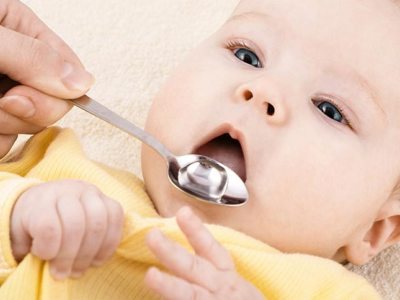
The occurrence of sputum in children
Sputum is the name given to secretions that are present in the trachea and bronchi. Sputum may be released along with saliva.
A certain mucus is constantly present in the bronchi, which serves as a cleanser of the respiratory organs from bacteria, germs and dust. The mucus is equipped with immune bodies. The daily rate of mucus secretion by a healthy body is approximately 100 ml.
Often, a “wet” cough occurs with diseases such as bronchitis or asthma, chronic rhinitis and even pneumonia. In the case of bronchitis, the type of sputum is an important factor. If there is pus or an unpleasant odor, then this is direct evidence of a violation of the respiratory system.
If your cough gets worse, you should urgently consult a specialist for a full analysis. Perhaps an inflammatory process is developing in the body.
Effective help for the child's body
Helping your own child is not so difficult. First you need to think about humidifying the air. If there is no special humidifier, then you need to use wet towels. Equally important is a constant supply of water to the child’s body.
To help remove mucus better, you can give your child an external massage of the respiratory organs. First, rub the baby's chest and back. Using your finger, tapping movements are made between the shoulder blades. The massage should take no more than 5 minutes.
Three procedures per week are enough. Badger fat or rich baby cream are suitable as a lubricant.
For older children, you can resort to vitamins. This is warmed milk with bee honey and butter. Cranberry or raspberry juice will help cope with a dry cough.
Nobody cancels the use of inhalations in the case of sputum. You can use medicinal mineral water as a basis. It is advisable to use a product under the Essentuki brand, which contains natural ingredients. In the case of this mineral water, the fact of purchasing counterfeit products is excluded.
As for medications that help increase sputum discharge, it is better to make an appointment with a specialist. There are a huge number of products that help thin mucus, accelerate its removal from the body, and also reduce inflammation in the bronchi.
If the child’s temperature does not rise, a bath and hot steam can help. Use a broom and medicinal herbs that can be placed on the stones (thyme, St. John's wort, mint and others).
So, let's summarize. If the issue of treatment affects a child, then self-medication should be completely excluded. Diagnostics should only be carried out by a specialist; he is the one who can distinguish bronchitis, pneumonia or rhinitis from a common cold. Any disease requires individual treatment, which means that the child’s body is not a place for experimentation. There is no need to endanger the health of a small organism.
Category: Children's health | Author: Pediatrician
Cough with runny nose
A solution of furatsilin helps children well, it is very simple to prepare: crush 5 tablets of furatsilin, pour 0.5 liters of water into them, boil until completely dissolved, cool (!), drop 1 drop into each nostril. You can also use children's nasal drops. It is better if you take such medications at least 2-3 times a day.
Don't forget about folk remedies. You can place small heated bags of salt on the sinuses, breathe in a warm and humidified room, bathe only in warm water with the addition of herbal infusions (chamomile, calendula, St. John's wort), if the child is not allergic to them. By the way, it is after a warm bath that it is easier for a child to cough up mucus, and the mucus comes out faster. It is good to cover the child with a blanket at night to avoid hypothermia.
If your baby has a runny nose, he needs to be given more warm drinks. The ideal option is to apply it to the breast more often. You can offer warm water or a mixture. Our grandmothers treated runny noses in infants in a very original way: they instilled 1 drop of breast milk into each passage.
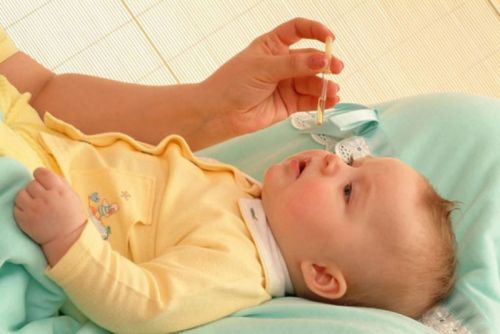
Furacilin disinfects the nasal cavity, washes away bacteria and the infection itself
Most often, the cause of such a cough is inflamed adenoids, which causes the tonsils in the throat to expand in a sick child. The baby will not be able to breathe through his nose and will be forced to breathe through the mouth. The airways dry out, the child begins to cough dryly and cannot clear his throat.
Another cause of cough with runny nose may be sinusitis. In this situation, mucus flows down the back of the throat and causes irritation.
Meanings of cough for the body
A cough is not only a sign of illness. With its help, adults and children cleanse the upper and lower respiratory tract. During the day, a child may cough for several reasons:
- inflammation develops;
- foreign body hit (choked);
- mucus flows from the nose along the back wall of the throat, irritating the cough receptors;
- an allergic reaction develops;
- The air the child breathes is dry and dusty (or smoky).

Foreign body - the cause of cough
Depending on what caused the cough, parents need to choose a tactic. Any cough should be treated not as a terrible symptom, but as a useful reflex that clears the airways of irritants.
On the walls of the pharynx and larynx there are special cough receptors, which, reacting to the slightest irritation, trigger the coughing mechanism only to expel the foreign substance. Each person’s brain also has a cough center, which is irritated for two reasons: from toxins secreted by pathogenic bacteria and by a signal from cough receptors in the respiratory tract.
Getting rid of phlegm with massage
Blockage of the airways with mucus during a coughing attack can lead to suffocation. In this case, parents should do the following:
- First of all, call an ambulance.
- Provide the child with a vertical body position.
- Open the window for fresh air.
- Use an inhaler if it has been previously prescribed by a doctor.
You can notice a dangerous condition in time by the blueness of the child’s nasolabial triangle, increased breathing, and a feeling of lack of air.
Traditional methods of treatment
There are two options for treating cough if the child is one year old. Can't your baby clear his throat? Use the following:
- Two types of expectorants: herbal and combined. Herbal remedies include: anise, ivy, plantain, thyme. Combination drugs are more effective because they contain chemicals
- Mucolytic drugs. Such medications help remove mucus more intensively.
There are also unconventional methods, they help no less. Most often, these are compresses with the most readily available substances. For example, a cabbage leaf smeared with honey helps a lot; it is recommended to apply it to the chest and on the back, but bypass the heart area. This is done before bed, the result is noticeable almost immediately.
With any disease, everyone needs to drink plenty of fluids. For this, beneficial herbs are used:
- Chamomile.
- Rosehip.
- A series.
- Various fruit drinks, etc.
Rubbing the body, in the absence of fever, is no less beneficial. Some oils are used for this. But the greatest effect of badger fat is that it is not only rubbed on the chest and back of the baby, but also drunk with hot milk. At the same time, any heating agents help remove phlegm and rubbing the heels. Such procedures do not cause side effects on the body, and the effect is noticeable the next day.
When the child is older, the environment, namely the conditions in the room, affect the child’s health. Therefore, you need to do wet cleaning more often, and also use air softening products. When the air in the room is fresh and humid, then it is easy for a child to clear his throat. It is not necessary to purchase special sprayers; you can simply place a damp towel on the battery.
Often, before a cough begins, bronchitis develops, in which sputum is formed, and the baby may complain of a sore throat. It’s good to use all the necessary means at this stage. Even inhalations can completely prevent the occurrence of serious abnormalities. Today in pharmacies there are special devices that make it easy to perform procedures.
An example of this is a nebulizer; there are many different special preparations for it that are of great benefit to any body. Now it is clear that coughing up phlegm at 1-2 years of age is not so difficult, but only if treatment is started on time, with the recommendation of a doctor and in a comprehensive manner. It also happens that some medications are not suitable for the child and do not bring results; in such a situation, complications cannot be avoided. Because of this, everything should begin with the appointment of a pediatrician.
What vaccinations are given to a newborn at 1 month - pros and cons How to help a child start walking independently - exercises
A newborn baby groans, arches and blushes
How is it better for a child to sleep with or without a pillow and at what age?
What can and cannot be eaten by a 5-6 month old bottle-fed baby
Cough is the body's response to illness. Coughing with sputum in a child helps remove infection from the body. But in some cases, the cough drags on, the sputum is difficult to clear from the child, leading to complications in the lungs and bronchi. The article suggests what to do if your child is unable to cough up sputum.
What types of sputum are there?
The effectiveness of cough relief largely depends on the diagnosis and the application of appropriate treatment. Sputum varies in consistency and color, which is determined by the nature of the disease.
Viscous transparent sputum in a child is characteristic of the initial stage of bronchitis, pneumonia and bronchial asthma. With pulmonary edema, liquid, foamy discharge is formed. When there is suppuration in the lungs (abscess, gangrene, actinomycosis), the child experiences green purulent sputum. About serious diseases in the lungs:
Parents, seeing how their baby is suffering from coughing, often become desperate and look for ways to help their child cough up sputum. General recommendations are as follows: give plenty of warm drinks, provide a flow of fresh air and in the absence of fever
- take the baby for a walk, give vitamin therapy. There are a number of phlegm thinners for children:
- herbal syrups. The composition of sweet children's syrups includes: sage, coltsfoot, licorice, marshmallow, oregano, eucalyptus, etc.;
- warm decoctions and lozenges with similar ingredients;
- mucolytic drugs recommended for children: Fluimucil, Acetylcysteine, etc.
- hot milk with mashed figs;
- cranberry, lingonberry juice with honey;
- viburnum, blackberry or raspberry juice with the addition of honey;
- rosehip decoction with honey;
- alkaline mineral water with milk;
- Tea with lemon.
When determining the best way to thin a child’s sputum, you can follow the recommendations of traditional medicine. In this case, use as a drink:
If there is no temperature, mustard plasters are placed on the baby's calves and upper chest. To prevent the patient from experiencing discomfort, it is advisable to place thin paper between the back and the mustard plasters. A wonderful remedy is a compress of mashed potatoes, to which a few drops of iodine and a dessert spoon of vegetable oil are added.
The potatoes are laid out on foil, wrapped like a chocolate bar and placed on the upper chest. A compress of cabbage leaves smeared with honey has a local warming effect. However, when using this compress, like all medicinal products with honey, you should be careful, because honey is a strong allergen. Warming rubs made from badger or marmot fat are great help.
Important: how to expectorate sputum can be explained to a child who has reached the age of two. Train him to spit mucus into the sink or disposable paper tissues. Traditional tissue handkerchiefs for colds are a breeding ground for infection!
Pharmacy products
In infancy, most traditional methods should not be used. However, for older children, many recipes for getting rid of phlegm will be effective. Here are some examples of how to remove accumulated clots:
- Warming the back and chest area with badger fat, warm bread or honey is a very effective remedy. The procedure is done at night, and then the child is warmly wrapped.
- A mixture of radish juice with honey or cranberry juice with honey. This tasty medicine is taken several times during the day.
Many adults know how to expectorate mucus using herbal or berry infusions. However, such alcohol products cannot be used in pediatric practice.
, how to remove phlegm from a child using safe means. At the same time, you need to be able to notice in time if the disease continues to progress. To avoid complications, it is always better to consult a pediatrician for proper treatment. Syrup for sputum removal, as well as moist and cool air in the room will help quickly clear the baby's airways and make breathing easier.
A cough, which is accompanied by thick secretions, is evidence that the child is beginning to recover. This condition indicates that the body cleanses itself by removing secretions from the bronchi. But in some cases, the sputum has a very viscous and thick structure and the baby has a very hard time coughing it up. This condition requires special treatment.
If the mucus is very thick, it may be difficult for your child to cough up the phlegm.
It is believed that medications are beneficial, but they must be used strictly as prescribed by a doctor. Most often, the use of sputum expectorants is used when nothing else helps the child. In addition, it also happens that the use of inhalers and other methods is not possible due to age or restrictions. If the child is less than three months old, it is difficult to use anything strong.
Today in pharmacies there are products that not only fight coughs, but also help remove phlegm. For kids, these are syrups:
- Overslept.
- Bromhexine.
- Lazolvan.
- Ambroxol.
Since these drugs are prescribed to children, it is better only after a recommendation from a doctor. Because each of them has its own contraindications. But the effect of them will come quickly and the sputum will completely come out. Most often, it is the pediatrician who prescribes the dosage, depending on age.
There are also situations when a patient needs urgent help. As soon as signs of the disease appear, it is necessary to fully monitor the patient’s condition. Because if the color of sputum turns green, it means the presence of bacteria and germs. It is in this situation that the child needs immediate help.
Causes of difficulty coughing
In order for sputum to easily move away from the walls of the bronchi and lungs, it should not be thick. Therefore, it is important to ensure that two important conditions are met to help cough up:
- The air in the room should be humid and cool (no warmer than +20˚C, humidified to 60%).
- A child over 6 months old should drink plenty of warm liquids.
Providing these two parameters is much more important than any medicines and folk methods that seek to teach how to make a child cough. Dried mucus accumulated in the respiratory tract interferes with normal inhalation and gas exchange processes. It significantly increases the duration of the disease and threatens with obstruction and other dangerous complications. The task of parents is not to persuade the child to cough up mucus, but to provide the body with favorable conditions for its removal.

The temperature of the drink you need to feed your child should be close to body temperature. If the baby has a fever, the compote should be heated to 38˚C. If hyperthermia is not observed, the temperature of the drink can be 36˚C.
Medications
If at an older age a child has a cough and does not cough up sputum, then the following groups of drugs are used:
- Anti-inflammatory: these medications are used to relieve inflammatory processes. They can only be prescribed by a doctor, since these drugs change the course of the disease and can cause an imaginary recovery. These include the medications Ibuprofen and Nurofen.
- Expectorants: they help the phlegm to leave the body of a sick child faster by strengthening the reflex. These drugs are called: “ACC”, “Ambrohexal”.
- Mucolytics: stimulate the removal of mucus from the lungs and thin it. Used when the child does not cough up phlegm. “Mukaltin” and “Bromhexine” are suitable here.
- Bronchodilators: most often prescribed for allergies. Bronchidilators have a bad effect on the heart. These are quite serious drugs that require specialist consultation before use. These are mainly inhalers: “Berotek”, “Berodual”.
- Antihistamines: stop the negative effects of histamine on the body. These drugs include Cetrin, Suprastin and Diphenhydramine.
To treat cough and enhance coughing, expectorants are used. It is best to give children medications that contain a natural base (for example, plant extract). These include:
- Gedelix. Available in syrup form and is suitable for treating children from birth. To give this mixture to a baby, it must be diluted in juice or water in accordance with the dosage indicated in the instructions.
- Linkas. Helps in thinning thick mucus that is difficult to clear, relieving inflammation and sore throat.
- Liquorice root. This medicine is available without a prescription and is suitable for children aged two years and older. It should be given to children without exceeding the dosage, since it contains the worst thing that affects the health of children - alcohol.
- Stoppussin. Sold in pharmacies in the form of drops, which must be diluted in juice or water.
Linkas - syrup that thins phlegm well
Drugs for treatment
There are two options for treating cough if the child is one year old. Can't your baby clear his throat? Use the following:
- Two types of expectorants: herbal and combined. Herbal remedies include: anise, ivy, plantain, thyme. Combination drugs are more effective because they contain chemicals
- Mucolytic drugs. Such medications help remove mucus more intensively.
If at an older age a child has a cough and does not cough up sputum, then the following groups of drugs are used:
- Anti-inflammatory: these medications are used to relieve inflammatory processes. They can only be prescribed by a doctor, since these drugs change the course of the disease and can cause an imaginary recovery. These include the medications Ibuprofen and Nurofen.
- Expectorants: they help the phlegm to leave the body of a sick child faster by strengthening the reflex. These drugs are called: “ACC”, “Ambrohexal”.
- Mucolytics: stimulate the removal of mucus from the lungs and thin it. Used when the child does not cough up phlegm. “Mukaltin” and “Bromhexine” are suitable here.
- Bronchodilators: most often prescribed for allergies. Bronchidilators have a bad effect on the heart. These are quite serious drugs that require specialist consultation before use. These are mainly inhalers: “Berotek”, “Berodual”.
- Antihistamines: stop the negative effects of histamine on the body. These drugs include Cetrin, Suprastin and Diphenhydramine.
Inhalations and mustard plasters
If the existing mucus is difficult to cough up, steam inhalation may be prescribed using herbal decoctions. Iodine, soda and essential oils are also perfect for steam inhalation. You already know what to do if the child cannot clear his throat.
But it is important to remember the safety rules for this method of treatment:
- The liquid should not be too hot.
- The steam should not be inhaled too deeply, as this may cause burns to the respiratory tract.
- This procedure is recommended for children over three years of age.
- Inhalation should be carried out no later than an hour after eating.
- In winter, after inhalation, you should not immediately go outside.
- Only a doctor can prescribe medications for inhalation.
It is not necessary to buy a solution for inhalation at a pharmacy; you can make it at home yourself. You will need water and honey in a 5:1 ratio. The water temperature should be approximately 45 °C.
The baby should be seated so that his face is above the solution, and it is advisable to cover the child with a blanket. You need to breathe first through your mouth, then through your nose, and so on in a circle.
Inhalation, of course, is a good method if the child has trouble coughing, but, unfortunately, it cannot always be used. This method cannot be used when the child:
- dry cough and the baby has difficulty breathing;
- sputum with pus and a bacterial infection;
- elevated temperature.
With all these signs, inhalation is contraindicated.
If the child cannot cough up mucus, inhalations can be used. This home treatment method is safe and very effective. It is best to resort to the help of a nebulizer - a special device sold in pharmacies. The modern medical equipment market produces ultrasound and compression devices.
For such procedures, you can use decoctions of medicinal herbs, for example, chamomile or coltsfoot. It should be remembered that any plant can cause allergies in a baby. When using inhalations, you need to be careful and make sure that the baby does not burn his face. In addition to herbs, you can use essential oils (eucalyptus, rosemary, lemon, fir).
Such substances thin out thick mucus in the bronchi, and the child will be able to cough normally. Inhalations have contraindications. Thus, such procedures cannot be used for children with diseases of the respiratory system, heart and blood vessels. In addition, inhalation can aggravate the course of the disease if carried out when the child’s body temperature is elevated.
Inhalations with fir oil are very useful; they make coughing easier.
No less effective are mustard plasters, which warm up the bronchi and help the child cough up mucus. They can be used only if the child is not allergic to mustard plasters. To quickly get rid of cough and liquefy secretions, the sheets are placed on the feet, in the interscapular area. The chest and back should also be involved. The procedure should last no more than 4 minutes. To prevent mustard plasters from burning the skin, you can lubricate it with baby cream.
In order for a child to remove phlegm better, the following rules must be followed:
- Humidify the air in the room where the baby is always present. Dry air will only aggravate the condition, while humid air, on the contrary, will help cough up secretions better. To do this, you can purchase a humidifier or hang wet towels over the radiators. It is also recommended to place containers of water around the room, into which you need to add a few drops of orange and eucalyptus essential oils.
Children should drink as much as possible if they have a severe cough.
- Give your child more to drink. This can be herbal tea (you need to consult a pediatrician so that such liquid does not cause allergies), compotes or juices. If the secretion is difficult to pass, ordinary mineral water is very helpful in thinning the mucus. You can not only drink it, but also gargle it.
- Give your baby vitamin complexes. It is during this period that the baby’s immune system is under attack. In order to protect it and increase the body's defenses, it is necessary to take vitamins. In addition, for the same purpose, you can give your baby ginger root or echinacea, provided that he is not allergic to it.
All of the tips listed will help to quickly dissolve the secretion and remove it from the respiratory tract.
Taking vitamin complexes will help stimulate the immune system
Mucolytic medications
3-4 days have passed since the start of treatment, and the child’s cough has not cleared up? Then modern synthetic mucolytic medications will help ease the expectoration of liquid and cure bronchitis. A substance called acetylcysteine (ACC, Fluimucin, Mukobene) has excellent reviews. The medicine qualitatively and instantly dilutes not only sputum, but also secretory mucus from the nose and pus, providing an anti-inflammatory effect.
For preschool children, there is ACC-100 - a special form. The product is diluted with water and has a pleasant taste. The duration of administration is determined by the nature and course of the respiratory tract disease and in the acute stage lasts from 3 days to a couple of weeks, in the chronic stage - a couple of weeks. If necessary, the course of treatment is sometimes repeated.
Ambroxol (syrup Lazolvan, Ambrohexal, Ambrobene) is recognized as the best mucolytic of our time.
Ambroxol, making mucus secretions liquid, has an enhanced coughing effect, has an anti-inflammatory effect, and strengthens the local immune system.
An important feature of this medicine is its ability to take part in increasing the lung superfractant - a substance that creates surface tension and improves the quality of distensibility in the lungs, which indirectly affects the improvement of expectoration of liquid.
It is possible to give ambroxol to a child from the first months of his life (even to a premature one). The duration of the course of treatment is one or three to four weeks, which depends on the effectiveness and nature of the disease. Bromhexine is also involved in thinning sputum, improving its removal. The product is relatively inexpensive, and there are forms for children. But its effectiveness is slightly lower than that of acetylcysteine and ambroxol.
A separate group includes mucoregulators - drugs with a mucolytic effect; they restore the healthy activity of the cells of the bronchial mucosa that produce secretions. These include medications containing carbocysteine (Mucodin, Bronkatar, Mucopront). However, their use provokes constipation in children.
Massage
It is worth mentioning other treatment methods when a child cannot clear his throat. What else can be done in these cases? Breathing exercises are a good option that helps sick children remove mucus from the body and strengthen the immune system. In order for such exercises to be beneficial, you need to do them correctly.
You can make a wet cough from a dry one without medications. To do this, you need to regularly moisten the room where the child is. It is enough to wet the towels and hang them on the radiators or just around the room.
If a child has a dry, persistent cough, then you need to fill the bath with hot water and add a little soda. At this point, the humidity in the bathroom will be high and this will be very beneficial for the baby's breathing.
If your child has a high temperature, you should not bathe him. If there is no temperature, then the child can be bathed by adding sea salt to the bath. After such a bath, the sputum should be cleared better.
A cough is not always a consequence of any disease. This condition may appear if the air in the room where the child is constantly present is dry or there is a large amount of dust. Also, the cause of the cough may be renovations carried out in the apartment. Paints and varnishes evaporate and have a negative effect on the child’s body.
There is a set of breathing exercises that will help relieve cough
Special gymnastics are very effective in combating cough. If the child is already over three years of age, you need to give him a whistle or pipe. After blowing in them for a while, the baby will be able to clear his throat. You can also invite your child to inflate balloons. The baby will not only take his mind off the disease, but will also train his breathing apparatus and increase the discharge of sputum. Such procedures can be carried out for no more than 3 minutes. Otherwise, there is a high risk of dizziness.
How can I help my child clear his throat in other ways? The “Bubbles” exercise will help you get rid of thick secretions. The child should take a deep breath through his nose and puff out his cheeks. After this, you need to slowly exhale all the air through your mouth, which should be slightly open. Such actions should be repeated no more than 4 times a day.
Children should do such exercises under parental supervision as they may become dizzy due to the large influx of oxygen into the lungs. If the child does not understand the principle of the exercise, then we help him by example and also cough. Pediatricians recommend performing these manipulations on an empty stomach, before breakfast or 2 hours after meals.
It is best if children do breathing exercises with their parents
Set of exercises
- “Let’s drop the load.” It is performed while standing, with your hands clenched into fists. We inhale - our palms open, we exhale - we relax the whole body. Then you need to tilt your neck forward and place your hands on your stomach.
- "Eight". We lean forward slightly, inhale and hold our breath. At this moment we slowly count to eight. After this, we exhale slowly.
- "Pump". Sit down as you exhale, stand up as you inhale.
- "Watch." Let's play a game. Feet shoulder-width apart, back straight, arms swinging and saying “tick-tock.”
- "Skis". Everything here is simple and clear. We simulate skiing movements for two minutes.
- “Growing big.” We stand on our toes, stretch up, and take a breath. As we exhale, we lower ourselves and relax the body.
- "Semaphore". The sick child stands up and puts his feet shoulder-width apart. As you inhale, raise your arms to the sides and slowly lower them as you exhale.
A set of breathing exercises should be performed for two to three months.
Such exercises undoubtedly have contraindications. It is not recommended to perform this set of exercises if the child has heart defects, with acute painful conditions associated with the lungs, if the baby has diseases such as bronchitis, acute pneumonia.
Traditional recipes for getting rid of phlegm
In addition to all sorts of different medications, there are also folk remedies for sputum discharge. Our grandmothers used them, and they never failed.
Remedies from traditional medicine will help cope with severe sputum discharge:
- Raw beet juice is very effective in combating this condition. It is necessary to peel the root vegetable and cut it into small slices. A child should eat no more than 25 g of this vegetable per day. Exceeding the norm is fraught with nausea and vomiting. You should not be treated with this remedy on an empty stomach, since beets irritate the walls of this organ. If the child does not want to eat such a root vegetable, you can squeeze the juice out of it and dissolve it in a small amount of water.
- To start coughing up the secretion, you can use radish. The vegetable should be grated or chopped (3 tbsp) and poured with liquid honey (1 tbsp). Mix and divide into several portions. This home remedy should not be given to children with gastrointestinal diseases or allergies to honey.
- A proven and effective medicine is onions with honey, which has a clearing effect. It needs to be finely chopped and squeezed out the juice through cheesecloth. Mix the resulting liquid (2 tbsp) with honey (1 tbsp) and give the child 0.5 tsp. no more than 2 times a day.
For a wet cough, you can prepare a remedy from beet juice.
All of the recipes listed not only help if mucus is difficult to clear, but also increase the body's immune defense. To prevent cough from reoccurring, special attention should be paid to prevention. The child should cover his nose and mouth when sneezing and coughing up mucus to prevent infection of other family members.
During colds, you should constantly wash your hands with soap with an antibacterial effect. To avoid getting sick, you need to monitor the temperature of the food you give your baby. It shouldn't be too cold. The same rule applies to drinks. Following these simple recommendations will help you avoid problems. After all, now you know what to do if your child cannot cough up phlegm on his own.
All children get sick often, but when they are small, their immune system is not ready to work actively. Today, children are exposed not only to acute respiratory viral infections and acute respiratory infections, but also to viral diseases. All of them are accompanied by main symptoms:
- runny nose.
- cough.
- temperature.
Since we are talking about a child, you should not self-medicate. It is the doctor who will be able to accurately establish the diagnosis and after that prescribe full treatment. It is clear that mucus collects in the nose and larynx, it provokes a cough, and also completely blocks the child’s air supply. And children aged 1-2 bear all this hard, they begin to be capricious and cry. It is important that all mucus comes out and does not remain inside.
Not every baby can cough easily; he will have to be helped with this. Bronchitis is especially difficult to tolerate, as it is accompanied by sputum discharge. Because in the process, inflammation of the mucous membrane and swelling occurs. After the swelling goes away, sputum begins to come out, and this is the main problem. It is easier to remove it from the nasal cavity, but not from the larynx. This is not only due to age, but also because the larynx is not fully formed.
In this case, the cough can be productive or wet. In babies, sputum can also form for other reasons. Most often, the mother begins to worry if there are additional symptoms:
- Increased body temperature.
- Poor appetite and sleep.
- Snore.
- Dyspnea.
Treatment should be carried out not on the symptoms, but on the very cause of the appearance of sputum. If the cough is severe, then this poses a danger to certain organs during the child’s development, namely:
- Insomnia.
- Nervous disorders.
- Hoarse voice.
- Vomit.
- Hernia development.
As soon as the first symptoms appear, it is necessary to select and begin treatment correctly. There are enough ways to relieve a cough and help children 1-2 years old to clear sputum. There are not only traditional methods using standard means, but also traditional medicine. To quickly achieve the desired effect you will need to use them together.
Such actions are beneficial for a child of any age. This is the best way to remove phlegm from the inside. However, you should not use it if the baby has a fever. This procedure lasts 5-10 minutes depending on age. Before starting, you need to give an expectorant. When a massage is given to a baby, it is better to do everything in a playful way, without whims, because otherwise you will not achieve the desired effect.
Initially, the skin on the back was rubbed so that it became slightly red. Next, make a boat-shaped palm, after which you need to slowly tap along the entire surface of the back, starting from the bottom up. As if pushing phlegm out to the larynx. This is done carefully, you can say some interesting words, in the form of a game.
Doctors also have other massage methods, so at the first signs of illness it is better to seek help from a pediatrician rather than conduct experiments on the child. There are good medications for children aged 1-2, they help no less.
Favorable conditions for a sick child
The conditions in which a child should be during illness are of great importance. List of minimum requirements:
- The air temperature should be approximately 20 °C.
- There must be fresh air in the room.
- The absence of dust, its presence can worsen the health of the child.
- Do not use perfumes, aerosols or household chemicals with a strong odor.
- Try to maintain the required humidity of 60%.
- A sick child should drink more, for example, hot tea.
- Do not forbid the child to move, take him out for a short walk. Activity will not harm, but on the contrary, it will help remove phlegm from the body.
- The child should sleep in a cool room, but in warm pajamas and always under a warm blanket.
- Feed when asked, and not according to a schedule and against the child’s wishes.
Why is phlegm difficult to cough up?
The appearance of sputum in a child may not be accompanied by a cough. This occurs due to allergies or due to infection. In the case of infection, pathogenic bacteria that are located in the bronchi are to blame. When complications occur, the mucus becomes elastic and sticky; the bronchial channels will not be able to pass mucus in such a consistency during breathing, which will lead to a dry cough.
In the case of allergies, the mucus also becomes viscous. Sputum production will increase if the body is affected by irritants (dust, fur, pollen). In this situation, the child will not be able to cough up mucus due to its large amount. Remaining mucus in the bronchi most often leads to exacerbation.
The danger of coughing for infants
Infants rarely get sick from viral or bacterial infections. A monthly cough most often occurs due to choking on milk or due to dry air in the room. If an infant is really sick, there is a certain danger. This is due to the fact that the tissues of the pharynx and trachea are abundantly lined with thin capillaries and vessels. When inflammation occurs, swelling immediately forms, which can block the lumen of the pharynx, blocking the passage of air. Therefore, any inflammatory process threatens suffocation.
Important! Any cough in an infant requires a mandatory examination by a doctor.
How to understand that a cough is dangerous for a child?
Cough can be a symptom of quite serious illnesses. In such situations, parents will not be able to eliminate the cough on their own. You need to call a doctor:
- If the child was healthy, but suddenly a severe cough appeared.
- If the cough is accompanied by wheezing.
- Paroxysmal cough, bloody or green sputum.
- If, along with a cough, a high temperature rises and does not decrease.
- The child cannot clear his throat at night.
Don't forget about prevention after treatment. It is recommended to drink hot tea with honey more often, continue the breathing exercises, and also strengthen the child’s body. Only all this needs to be done correctly and carefully. These recommendations also include healthy, sound sleep, walking in the fresh air for at least two hours a day.
Don't forget to take vitamins, especially in autumn and spring. Many doctors advise excluding cow's milk, canned food, sugar, marinades and sausages from children's diets. Instead, you should add the following products: vegetables (zucchini, peppers and cauliflower), fruits, fish, dairy products, beans, peas, eggs and raisins.
Possible complications in the child
All diseases of the ENT organs must be treated correctly and completely, otherwise serious complications may arise
One of the most dangerous complications of any respiratory disease, accompanied by copious sputum production, is pneumonia, or pneumonia.
Moreover, the younger the child, the higher the risk for his future health, since the lungs of a very tiny child are still very weak, completely unformed and fragile. Pneumonia can cause significant harm to a child’s health and cause a number of diseases that can haunt the child even into adulthood.
Another dangerous complication is the transition of the disease to a chronic form. The longer the infection is present in the child’s body, the greater the risk of various complications.
It would seem that a common cold with a cough can have a detrimental effect on the functioning of the child’s cardiovascular system, the functioning of the kidneys and genitourinary organs.
Since the skull bones of a small child are especially thin and porous, an untreated disease with profuse sputum can lead to infection spreading to neighboring organs. And these are the ears, throat, oral and nasal cavities, and even the brain. Complications may include bronchitis, pharyngitis, laryngitis, chronic rhinitis, sinusitis, sinusitis and sinusitis, inflammation of the middle ear and other ENT diseases, even potentially fatal damage to the membranes of the brain - meningitis.
More information about how and how to treat a child’s cough can be found in the video:
Remedies for the common cold for children under one year of age: effective drugs and their use
No matter how simple a cold with a runny nose and cough with sputum may seem, treatment of the disease should be immediate and preferably with a visit to the doctor. There is no need to neglect medical help - in some cases, parents are not able to recognize the symptoms of dangerous diseases, and in the early stages they are quite easy to cure.
